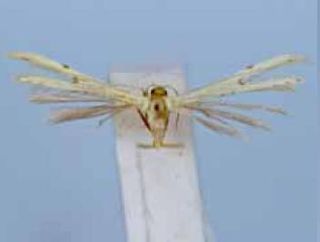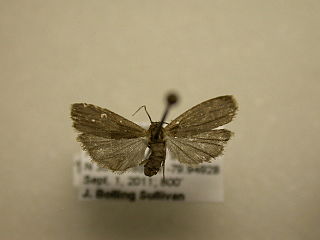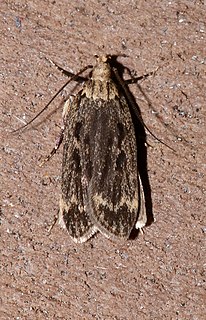
Enyo lugubris, the mournful sphinx, is a moth of the family Sphingidae. It is found from Argentina and Paraguay to Uruguay, Venezuela, Guyana, Surinam, French Guiana, Colombia, Ecuador, Peru, Brazil and the West Indies through Belize, Guatemala, Honduras, El Salvador, Nicaragua, Costa Rica and Panama to Mexico and the United States, where it has been recorded from Arizona east to Florida and north to South Carolina. Strays have been recorded from Arkansas, north to Illinois, Michigan and New York.

Oligoria is a genus of butterflies in the family Hesperiidae. It contains only one species, the twin-spot skipper which is found in the United States along the coast of North Carolina south through Florida and west along the Gulf Coast to east Texas. Strays can be found as far north as Pennsylvania, Maryland and New Jersey.

Calpodes ethlius, the Brazilian skipper, larger canna leafroller or canna skipper, is a butterfly of the family Hesperiidae. It is found in the United States from southern Florida and southern Texas, south through the West Indies, Mexico, and Central America to Argentina. Strays and temporary colonies can be found north to southern Nevada, northern Texas, Illinois and Massachusetts.

Adaina bipunctatus is a moth of the family Pterophoridae. It is found in the United States, including Florida and Mississippi. It has also been recorded from Trinidad, the West Indies, Brazil and Ecuador.

Adaina simplicius is a moth of the family Pterophoridae. It is found in the United States, Brazil, Costa Rica, Ecuador, Paraguay and Puerto Rico. It was introduced to South Africa for study as a biological control agent for Eupatorium macrocephalum.
Baphala pallida is a species of snout moth in the genus Baphala. It was described by John Henry Comstock in 1880 and is found in the US states of Texas, Utah, Alabama, Arizona, California, Florida, Maryland, Oklahoma and South Carolina.
Macrorrhinia parvulella is a species of snout moth in the genus Macrorrhinia. It was described by William Barnes and James Halliday McDunnough in 1913 and is known from the US states of Florida and South Carolina. It is also found in Colombia.

Crambidia lithosioides, the dark gray lichen moth, is a moth of the family Erebidae. It was described by Harrison Gray Dyar Jr. in 1898. It is found in the United States from North Carolina to Florida and from Kentucky to Mississippi.
Neargyractis slossonalis, the dimorphic leafcutter moth, is a moth in the family Crambidae. It was described by Harrison Gray Dyar Jr. in 1906. It is found in Cuba and the south-eastern United States, where it has been recorded from Alabama, Florida, South Carolina, Georgia and Mississippi.
Neodactria caliginosellus, the corn root webworm or black grass-veneer, is a moth in the family Crambidae. It was described by James Brackenridge Clemens in 1860. It is found in North America, where it has been recorded from Alabama, Alberta, California, Florida, Georgia, Illinois, Indiana, Maine, Maryland, Mississippi, North Carolina, Ohio, Oklahoma, Ontario, South Carolina and Tennessee. The habitat consists of grassy areas and fields.

Herpetogramma phaeopteralis, the dusky herpetogramma or tropical sod webworm, is a moth in the family Crambidae. It was described by Achille Guenée in 1854.

Aroga trialbamaculella, the red-striped fireworm moth, is a moth of the family Gelechiidae. It is found in the United States, where it has been recorded from Maine to Florida and from Illinois to Texas.

Lineodes integra, the eggplant leafroller moth or nightshade leaftier, is a moth of the family Crambidae. It is found from the southern United States, south to Chile. It has also been recorded from Illinois, Michigan, Ontario and Cuba.

Lineodes interrupta is a moth in the family Crambidae. It was described by Zeller in 1873. It is found in Mexico and the United States, where it has been recorded from Florida, Louisiana, Oklahoma and Texas.
Lineodes triangulalis is a moth in the family Crambidae. It was described by Heinrich Benno Möschler in 1890. It is found in Cuba, Puerto Rico, Jamaica, Dominica, the Bahamas, Mexico, Honduras, Guatemala, Colombia, Trinidad and Venezuela. In the United States it has been recorded from Florida and Texas.
Loxomorpha flavidissimalis is a moth in the family Crambidae. It was described by Augustus Radcliffe Grote in 1877. It is found in the United States, where it has been recorded from Texas, Florida, North Carolina and West Virginia. It is also found in Mexico and Puerto Rico. It has also been recorded from Australia.
Helcystogramma melantherella is a moth in the family Gelechiidae. It was described by August Busck in 1900. It is found in North America, where it has been recorded from North Carolina south to Florida and west to Texas and Arkansas.
Symmetrischema capsica, the pepper flowerbud moth, is a moth in the family Gelechiidae. It was described by John David Bradley and Dalibor F. Povolný in 1965. It is found Mexico, the West Indies, the Caribbean and the south-eastern United States, where it has been recorded Florida and Texas.

Martyringa xeraula, the Himalayan grain moth, is a moth in the family Lecithoceridae. It was described by Edward Meyrick in 1910. It is found in India (Assam), western China, Japan and North America, where it has been recorded from Louisiana, Texas and from Florida to South Carolina.

Lineodini is a tribe of the species-rich subfamily Spilomelinae in the snout moth family Crambidae.












